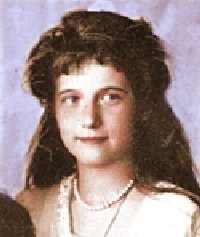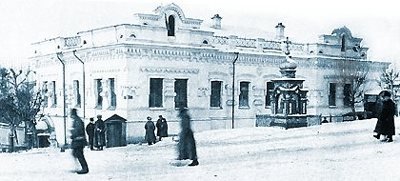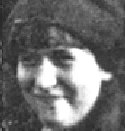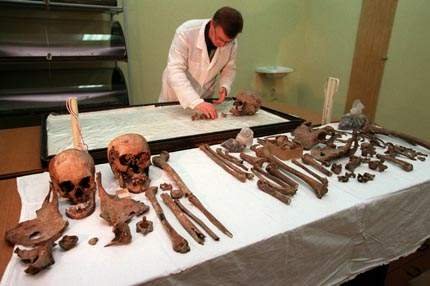by Emily S. Jacobs

Anastasia Romanov
Anastasia Romanov, the fourth daughter of Tsar Nicholas II of Russia, was born in the Peterhof Palace in July of 1901. For twelve years, she live the privileged life of a czarina, painting with watercolors, and playing with her little dogs.
When Anastasia was twelve years old, World War I broke out with Germany. During one of the two revolutions Russia would have to face during that war, Her father Nicholas was forced to give up his throne, ending the three hundred year reign of the Romanovs in Russia. The second revolution called "The Ten Days That Shook the World" put the Bolsheviks (Communists) in charge of Russia.

Ipatiev House - Where the last of the Romanovs were executed.
In 1918, the Romanov family was taken to Yekaterinburg, to the house of a man who had been arrested by the Bolsheviks and forced to leave his belongings behind. On the night of July 16, 1918, the Bolsheviks told the Romanovs to go down into the basement and line up. They told them that they would be taking a family portrait before the family was transported to another house. With the royal family all together, the guards opened fire upon them. It is said that some of the girls had diamonds sewn inside their clothing, to smuggle away, and that because of this the girls were not all killed in the first attempt. The bullets ricocheted off, so the executioners then bayoneted them after shooting them. None of the Romanovs at Yekaterinburg were ever seen again. Or were they?
In 1920, a young woman was rescued from a river in Germany after a failed suicide attempt. She was admitted into a mental hospital, and it was not until eighteen months later that she gave her identity, as the Grand Duchess Anastasia.
The mysterious woman seemed to have information about the royal family and Anastasiaís life that only Anastasia or somebody closely associated with them would have. There seemed to be a lot physical evidence to support her claim that she had managed escaped the firing squad alive.
And how did Anna say that she escaped? She claimed that she was bayoneted, but that the weapons were not sharp, and she survived multiple wounds. One soldier realized that she was alive, and took mercy on her, using the jewels in the hems of her skirts to help her escape toward Germany, where her motherís family lived.
But was her story true? She did have the necessary old bullet and bayonet wounds, and it is undeniable that Anna Anderson, as she came to call herself to escape the media, looked like the Grand Duchess.
 |
 |
Anna Anderson also had the same deformity on her foot that Anastasiaís doctor had looked at just before her family was captured.
Anna Anderson would not (could not?) speak Russian, but could understand it. When she was spoken to in Russian, she would answer in German, or English. It was said that the trauma of seeing her family die had made her lose her Russian, but was this the reason she would not speak it?

Anna Andersonís story is so captivating
Fox released an animated cartoon about it in 1997.
Anna Anderson eventually went to the surviving relatives of the royal family to see if they recognized her, but they turned her away saying that she was not Anastasia. She later moved to the United States and married an American. She went to her death still claiming that she was the Princess Anastasia.
Eventually, years after Anna Andersonís death, the relatives may have finally been proven correct. Recent DNA tests have identified the murdered family of Tsar Nicholas II. But although the Russian government has indentified the bodies, the bones are so damaged and mixed together that it has made it pretty much impossible to completely identify the individual children. The number of children's bodies found were short two of the children (most probably Alexei and Maria), but the DNA of those bodies found all matched the royal family.*

The bones of Tsar Nicholas and his family.
So who was Anna Anderson? It has been proposed that she was Franziska Schanzkowska, a young Polish mine worker, who disappeared just before Anna Anderson was found.
Whatever you personally decide about Anna Anderson being Anastasia, youíll find a lot of people and evidence that will back whatever decision you make. I am very partial to scientific evidence (i.e. the DNA test), but even now I still find myself doubting, every now and again, my personal belief that she wasnít the Princess Anastasia.
* In 2007 a top local Russian archaeologist Andrei Sidikov discovered the remains of two bodies that may be these of Alexei and Maria in a burned area of ground near Yekaterinburg. The Russian government has reopenned the investigation. The other remains of the rest of the royal family were reburied in St. Petersburg in 1998.
Sources:"Trackstar: Anastasia: Did she survive?" @ http://scrtec.rtec.org/track/tracks/t05723.html, 4/17/00.
"Was She Really Grand Duchess Anastasia?" @ http://www.best.com/users/~samsloan/forkunio.htm, 4/19/00
"Her Imperial Highness Grand Duchess Anastasia Historical Society" @ http://www.concentric.net/~Tsarskoe/, 4/19/00
"My Name is Anastasia" @ http://www.alexanderpalace.org/anastasia/, 4/21/00
Picture #1 - "My Name is Anastasia" from: http://www.alexanderpalace.org/anastasia/, 4/21/00
Picture #2 - "My Name is Anastasia" from: http://www.alexanderpalace.org/anastasia/, 4/21/00
Picture #3 - "Was She Really Grand Duchess Anastasia?" from: http://www.best.com/users/~samsloan/forkunio.htm, 4/19/00
Picture #4 - "Her Imperial Highness Grand Duchess Anastasia Historical Society" from: http://www.concentric.net/~Tsarskoe/, 4/19/00
Picture #5 - "Photo of the Bones of Czar Nicholas II" from: http://www.best.com/users/~samsloan/czarbone.htm, 5/22/00